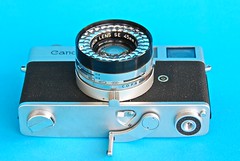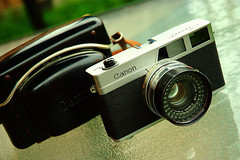Difference between revisions of "Canon Canonet"
m |
(Corrected some links and put margin on top picture) |
||
| Line 19: | Line 19: | ||
|flash = cable connector for M or X sync. | |flash = cable connector for M or X sync. | ||
|weight = 700g (?oz) }} | |weight = 700g (?oz) }} | ||
| − | + | <div class="floatleft plainlinks" style="margin:0px 10px 10px 0px;"> | |
{{Flickr_image | {{Flickr_image | ||
|image_source= http://www.flickr.com/photos/robnwatkins/1438376377/in/pool-camerawiki | |image_source= http://www.flickr.com/photos/robnwatkins/1438376377/in/pool-camerawiki | ||
|image= http://farm2.staticflickr.com/1322/1438376377_47e1bb472b_m.jpg | |image= http://farm2.staticflickr.com/1322/1438376377_47e1bb472b_m.jpg | ||
| − | |image_align= | + | |image_align= |
|image_text= The original Canonet | |image_text= The original Canonet | ||
|image_by= -RobW- | |image_by= -RobW- | ||
|image_rights= non-commercial | |image_rights= non-commercial | ||
}} | }} | ||
| + | </div> | ||
The Canon Canonet was released in 1961 and is remembered as [[Canon]]'s first entry into the intermediate-class camera market, and also the first of the highly successful Canonet series of [[35mm]] automatic-exposure [[rangefinder cameras]]. | The Canon Canonet was released in 1961 and is remembered as [[Canon]]'s first entry into the intermediate-class camera market, and also the first of the highly successful Canonet series of [[35mm]] automatic-exposure [[rangefinder cameras]]. | ||
| − | The top plate only houses the shutter-release, with a | + | The top plate only houses the shutter-release, with a locking ring for time-exposures, the frame counter and an accessory shoe. |
| − | |||
| − | |||
| + | The clean lines of the top are achieved by putting the [[film advance|advance lever]] underneath, together with the rewind crank, rewind release and back catch. The advance lever had an end which hinged downwards, making it easy to operate using the left middle- or third-finger. These controls on the bottom necessitate corresponding holes in the every-ready case. | ||
| + | <br/><br/> | ||
{{Flickr_image | {{Flickr_image | ||
|image_source= http://www.flickr.com/photos/heritagefutures/4754029289/in/pool-camerawiki | |image_source= http://www.flickr.com/photos/heritagefutures/4754029289/in/pool-camerawiki | ||
| Line 50: | Line 51: | ||
|image_rights= with permission | |image_rights= with permission | ||
}} | }} | ||
| − | |||
[[Rangefinder (device)|Rangefinder]] focusing is controlled by a lever attached to the focus ring, also at the bottom of the camera. | [[Rangefinder (device)|Rangefinder]] focusing is controlled by a lever attached to the focus ring, also at the bottom of the camera. | ||
| Line 71: | Line 71: | ||
== Links == | == Links == | ||
* [http://www.canon.com/about/history/episode04e.html Canonet at www.canon.com] | * [http://www.canon.com/about/history/episode04e.html Canonet at www.canon.com] | ||
| − | * [http://www.kyphoto.com/classics/instructionmanuals.html Manual available | + | * [http://www.kyphoto.com/classics/instructionmanuals.html Manual available at the Favorite Classics section of .kyphoto.com] |
| − | * [http://www.canon.com/camera-museum/camera/film/data/1956-1965/1961_net.html?lang=undefined&categ=srs&page=net&p=1 Canonet | + | * [http://www.canon.com/camera-museum/camera/film/data/1956-1965/1961_net.html?lang=undefined&categ=srs&page=net&p=1 Canonet] at the [http://www.canon.com/camera-museum/ Canon Camera Museum] |
| − | * [http://www.collection-appareils.fr/x/html/page_standard.php?id_appareil=10536 Bell & Howell Canonet 19] | + | * [http://www.collection-appareils.fr/x/html/page_standard.php?id_appareil=10536 Bell & Howell Canonet 19] at Sylvain Halgand's [http://www.collection-appareils.fr/ Collection Appareils] |
{{br}} | {{br}} | ||
Revision as of 23:58, 24 January 2015
| Canon Canonet |
|---|
|
Manufacturer: Canon
Film type: 35mm
|

|
| The original Canonet image by -RobW- (Image rights) |
The Canon Canonet was released in 1961 and is remembered as Canon's first entry into the intermediate-class camera market, and also the first of the highly successful Canonet series of 35mm automatic-exposure rangefinder cameras.
The top plate only houses the shutter-release, with a locking ring for time-exposures, the frame counter and an accessory shoe.
The clean lines of the top are achieved by putting the advance lever underneath, together with the rewind crank, rewind release and back catch. The advance lever had an end which hinged downwards, making it easy to operate using the left middle- or third-finger. These controls on the bottom necessitate corresponding holes in the every-ready case.

|
| ...with wind & rewind levers on bottom image by Dirk HR Spennemann (Image rights) |

|
| The Canonet's clean top panel... image by Dirk HR Spennemann (Image rights) |
Rangefinder focusing is controlled by a lever attached to the focus ring, also at the bottom of the camera.
The selenium meter cell is arranged around the Canon SE 45mm f1.9 lens - thus automatically compensating for filters; the aperture ring is scaled from f16 down to f1.9, followed by an "auto" setting (with a latch), for shutter priority automation. The Copal SV shutter has speeds from 1/500 down to 1sec, plus B. Film speed is set between 10-400 ASA by a lever in the shutter speed ring. The viewfinder features a bright-line frame, and a scale showing the aperture.
There is a PC socket beside the lens, and a switch on the lens barrel for X- or M-flash sync.
There is a self-timer - set by a lever on the lens barrel.
The Canonet was also sold by Bell & Howell as the Bell & Howell / Canon Canonet 19.
Historical Notes
Canon, at the time known as a high-end camera maker, caused commotion in the industry at the idea of this mid-priced camera. However, initial stocks sold out in only two hours after release. Within two and a half years, a million Canonets had been sold[1], and successive Canonet models continued into the mid 1970s. The Canonet name was also used for some 8mm cine cameras, as Cine Canonet.
References
Links
- Canonet at www.canon.com
- Manual available at the Favorite Classics section of .kyphoto.com
- Canonet at the Canon Camera Museum
- Bell & Howell Canonet 19 at Sylvain Halgand's Collection Appareils
